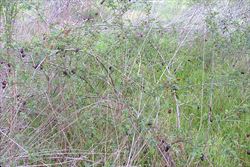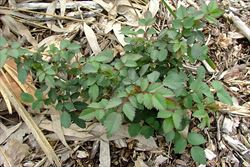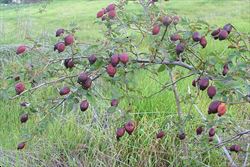Click on images to enlarge

infestation (Photo: Sheldon Navie)

habit (Photo: Sheldon Navie)

habit showing arching stems (Photo: Sheldon Navie)

habit of young plant with new growth (Photo: Sheldon Navie)

younger stem with thorns and leaves with sharply toothed leaflets (Photo: Sheldon Navie)

the once-compound leaves have five or seven leaflets (Photo: Sheldon Navie)

mature fruit (Photo: Sheldon Navie)

mature fruit (Photo: Sheldon Navie)

close-up of mature fruit without any spines (Photo: Sheldon Navie)

close-up of seeds (Photo: Steve Hurst at USDA PLANTS Database)
Scientific Name
Rosa canina L.
Synonyms
Family
Rosaceae
Common Names
briar rose, common briar, dog rose
Origin
Native to Europe, the Madeira Islands, the Canary Islands, north-western Africa (i.e. Algeria, Morocco and Tunisia), western Asia and the Indian Sub-continent (i.e. Pakistan).
Cultivation
Dog rose (Rosa canina) is cultivated as a garden ornamental, and is often used as a hardy grafted rootstock for other garden roses.
Naturalised Distribution
This species is widely naturalised, but scattered, in southern and eastern Australia. It is mainly found near settlements in the southern parts of the country. It is most common in Tasmania, Victoria and south-eastern South Australia. Less common in some parts of central and southern New South Wales, in the cooler parts of south-eastern Queensland, in other parts of South Australia and in the coastal districts of south-western Western Australia. Also sparingly naturalised in the ACT.
Widely naturalised overseas, including in New Zealand, Canada and the USA.
Habitat
A weed of native bushland, open woodlands, roadsides, fence-lines, waste areas, waterways, hedgerows and pastures that is found mainly in temperate regions.
Habit
A scrambling, or sometimes climbing (i.e. scandent), prickly shrub forming dense thickets and usually growing 1-3 m tall, but sometimes reaching up to 5 m in height when climbing up over other vegetation.
Distinguishing Features
- a scrambling, or sometimes climbing, prickly shrub forming dense thickets and growing 1-5 m tall.
- its smooth and hairless stems are armed with scattered prickles (up to 10 mm long).
- its once-compound leaves have 5-7 leaflets (each 1.5-4 cm long and 1-2 cm wide) with sharply toothed margins.
- its flowers (2-5 cm across) have five pale pink to bright pink petals and are borne on a hairless stalks.
- its smooth and hairless fruit (1-2 cm long) is oval or rounded and turns orange or scarlet red as it matures.
Stems and Leaves
The upright (i.e. erect) or arching stems (3-5 m long) are green or reddish-brown in colour when young, but become greyish-brown and woody as they mature. These stems are smooth in texture and hairless (i.e. glabrous), but they are armed with scattered prickles (up to 10 mm long).
The alternately arranged leaves are once-compound (i.e. pinnate) with 5-7 leaflets and are borne on a prickly stalk (i.e. petiole). The leaflets (1.5-4 cm long and 1-2 cm wide) are egg-shaped in outline (i.e. ovate) or broadly oval (i.e. elliptic) in shape and have sharply toothed (i.e. serrate) margins. They are either hairless (i.e. glabrous) or have a sparse covering of sticky (i.e. glandular) hairs. A pair of leafy bracts (i.e. stipules) is also present near the base of each leaf stalk.
Flowers and Fruit
The relatively large flowers (2-5 cm across) are borne in small clusters at the tips of the branches. They have five pale pink to bright pink petals (sometimes white), numerous stamens, and five backwards curving (i.e. reflexed) sepals that are variously toothed or lobed (i.e. pinnatifid). These flowers are borne on stalks (i.e. peduncles) that are hairless (i.e. glabrous) and not prickly. Flowering occurs mostly during late spring and early summer (i.e. from October to December).
The fruit is an oval (i.e. ellipsoid) or rounded (i.e. globular) fleshy capsule (known as a hip) that turns from green to orange or scarlet red in colour as it matures. These fruit (1-2 cm long) are hairless (i.e. glabrous), topped with the remains of the sepals, and contain numerous seeds. The seeds are yellowish in colour and irregularly shaped (4.5-6 mm long).
Reproduction and Dispersal
This plant reproduces mostly by seed, but may also produce new shoots from its long-lived (i.e. perennial) rootstock.
Seeds are mainly dispersed by birds and other animals that eat the fruit. They may also be spread in dumped garden waste.
Environmental Impact
Dog rose (Rosa canina) is regarded as a significant environmental weed in South Australia and is actively managed by community groups in this state. It is also a minor or potential environmental weed in other parts of southern Australia, and was recently listed as a priority environmental weed in at least one Natural Resource Management region.
Legislation
This species is declared under legislation in the following states and territories:
- South Australia: 3* - declared in Class 3d, a designation for briars. This species is required to be controlled in part of the state only.
- Western Australia: Prohibited - on the prohibited species list and not permitted entry into the state.
Similar Species
Dog rose (Rosa canina) may be confused with sweet briar (Rosa rubiginosa) and Macartney rose (Rosa bracteata). These species can be distinguished by the following differences:
- dog rose (Rosa canina) has hairless (i.e. glabrous) flower stalks and sepals. Its leaves are mostly hairless with leaflets that have pointed tips. Its flowers are pale pink to bright pink in colour and its fruit are hairless (i.e. glabrous) and unadorned, except for the remains of the sepals.
- sweet briar (Rosa rubiginosa) has flower stalks and sepals with sticky (i.e. glandular) hairs or spines. Its leaves have sticky (i.e. glandular) hairs on their undersides, and along their margins, and the leaflets have almost rounded tips. Its flowers are pink or white in colour and the bases of its fruit are sometimes adorned with bristles and/or small spines.
- Macartney rose (Rosa bracteata) has flower stalks and sepals that are densely covered with hairs or spines. Its leaves are mostly hairless, except for a few hairs on their midrib. Its flowers are white in colour and its fruit are densely hairy (i.e. pubescent).

